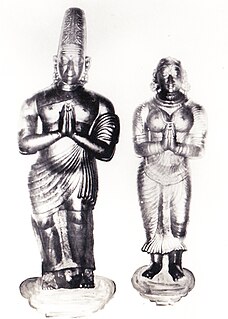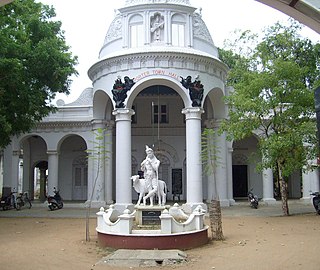
Shri Raghavendra (c.1595–c.1671) was a Hindu scholar, theologian and saint. He was also known as Sudha Parimalacharya. His diverse oeuvre include commentaries on the works of Madhva, Jayatirtha and Vyasatirtha, interpretation of the Principal Upanishads from the standpoint of Dvaita and a treatise on Purva Mimamsa. He served as the pontiff of the Madhvacharya Mutt at Kumbakonam from 1624 to 1671. Raghavendra was also an accomplished player of the Veena and he composed several songs under the name of Venu Gopala. His shrine at Mantralayam attracts thousands of visitors every year.

Madhvacharya, sometimes anglicised as Madhva Acharya, and also known as Pūrna Prajña and Ānanda Tīrtha, was a Hindu philosopher and the chief proponent of the Dvaita (dualism) school of Vedanta. Madhva called his philosophy Tatvavāda meaning "arguments from a realist viewpoint".
Vidyaranya is variously known as a kingmaker, patron saint and high priest to Harihara I and Bukka Raya I, the founders of the Vijayanagara Empire. He was the 12th Jagadguru of the Śringeri Śarada Pītham from 1380-1386.
Madhusūdana Sarasvatī (c.1540–1640) was an Indian philosopher in the Advaita Vedānta tradition. He was the disciple of Viśveśvara Sarasvatī and Mādhava Sarasvatī, and is the most celebrated name in the annals of the great dvaita-advaita debate. His Advaitasiddhi is a somewhat classic work, and most Advaita teachers maintain that all the logical issues raised by the dvaita school of Ananda Tīrtha are sufficiently answered by Madhusūdana.

Sri Jayatirtha or Jayateertharu, also known asTeekacharya was a Hindu philosopher, dialectician, polemicist and the sixth pontiff of Madhvacharya Peetha. He is considered to be one of the most important seers in the history of Dvaita school of thought on account of his sound elucidations of the works of Madhvacharya. He is credited with structuring the philosophical aspects of Dvaita and through his polemical works, elevating it to an equal footing with the contemporary schools of thought. Along with Madhva and Vyasatirtha, he is venerated as one of the three great spiritual sages, or munitraya of Dvaita.

Sripadaraya or Lakshminarayana Tirtha (c.1422-c.1480) was a Dvaita scholar, composer and the pontiff of the Madhvacharya mutt at Mulbagal. He is widely considered as the founder of Haridasa movement along with Narahari Tirtha. His songs and hymns, written under the nom-de-plume of Ranga Vitthala, contain the distillation of Dvaita principles infused with mysticism and humanism. He is also credited with the invention of the suladi musical structure and composed 133 of them along with several kirtanas. He was the advisor of Saluva Narasimha Deva Raya and mentored the young Vyasatirtha. He has also authored a commentary on Jayatirtha's Nyaya Sudha called Vagvajra.

Sri Vadiraja Tirtha was a Dvaita philosopher, poet and mystic. A polymath of his time, he authored many works, often polemical, on Madhva theology and metaphysics. Additionally, he composed numerous poems and as the pontiff of Sodhe Mutt, renovated the temple complex at Udupi and established the Paryaya system of worship. He is also credited with enriching the Kannada literature of the time by translating Madhva's works to Kannada, giving impetus and contributing to the Haridasa movement. His works are characterised by their poetic flourishes, incisive wit and humour.

The Haridasa devotional movement originated in Karnataka, India, after Madhvacharya, and spread to eastern states such as Bengal and Assam of medieval India. Over a span of nearly six centuries, several saints and mystics helped shape the culture, philosophy and art of South India in general and Karnataka in particular by exerting considerable spiritual influence over the masses and kingdoms that ruled South India.

Narahari Tirtha was a scholar and one of the disciples of Madhvacharya. He is considered to be the progenitor of the Haridasa movement along with Sripadaraja. Though only 2 of his scholarly works are extant, they are characterised by their verbosity and lack of digressions. A few songs of his survive under the nom de plume Raghukulatilaka. As a minister of considerable influence to the Eastern Ganga rulers and later as the pontiff of Madhvacharya mutt, Narahari converted the Simhachalam temple into an educational establishment of renown and a religious centre for Vaishnavism.

Padmanabha Tirtha was a Dvaita scholar and the disciple of Madhvacharya. Ascending the pontifical seat after Madhva, he served as the primary commentator of his works and in doing so, significantly elucidated Madhva's terse and laconic style of writing. His pioneering efforts in expanding upon the Dvaita texts to uncover the underlying metaphysical intricacies was taken forward by the 14th Century philosopher, Jayatirtha. Padmanabha is also credited with disseminating the philosophy of Dvaita outside the Tulunadu.

The Madhva tradition is a denomination within the Vaishnavism tradition of Hinduism, founded by the thirteenth century philosopher Madhvacharya. It is a movement in Hinduism that developed during its classical period around the beginning of the Common Era. Philosophically, Madhva tradition is aligned with Dvaita Vedanta, and regards Madhvacharya as its founder or reformer.

Govinda Dikshita (Dikshitar) was the minister of three successive Nayaks of Thanjavur, who ruled the region of Thanjavur in South India between the 16th and 17th centuries CE.
Navabrundaavana is located at Anegundi, near Hampi, Karnataka, India. It contains the Brundaavanas of nine Hindu Madhva saints, who belong to the Uttaradi Mutt, Sri Raghavendra mutt, Sri Vyasaraja mutt and the Sri SriPadaraja mutt and Other Various Prominent Madhwa Mutts. It is located on an island in the Tungabhadra River. The nine saints are
- Shree Padmanabha Tirtha, direct disciple of Jagadguru Shri Madhvacharya
- Shree Kavindra Teertharu
- Shree Vageesha Teertharu
- Shree Raghuvarya Teertharu
- Shree Vyaasa Teertharu or Vyasaraajaru
- Shree Sudheendhra Teertharu
- Shree Srinivaasa Teertharu
- Shree Raama Teertharu
- Shree Govinda Vodeyaru
Raghunatha Nayak was the third ruler of Thanjavur, southern India, from the Nayak dynasty. He ruled from 1600 to 1634 and is considered to be the greatest of the Thanjavur Nayak kings. His reign is noted for the attainments of Thanjavur in literature, art and Carnatic music.
Satyapramoda Tirtha was the pontiff of Uttaradi Matha, a math (mutt) dedicated to Dvaita philosophy, which has a large following in southern India. He was the 41st pontiff of Uttaradi Matha since Madhvacharya, the chief proponent and the one who rejuvenated this Dvaita philosophy.

Sudhindra Tirtha was a Dvaita philosopher of aesthetics, dramatist and the pontiff of the matha at Kumbakonam. Unlike his predecessors who mainly dealt with polemics and theology, most of his written works deal with Kavya (poetry), Alankara and Nataka (drama), which is considered unique in history of Dvaita literature. He is also notable as a disciple of Vijayendra Tirtha and for mentoring Raghavendra Tirtha who subsequently succeeded him as the pontiff of the matha at Kumbakonam. Regarding his oeuvre in the context of Dvaita literature, Sharma notes "he was left us works of real merit, which stand out like oases in the dreary desert of theological writings". His works are characterised by alliterations, elegance and simplicity.










